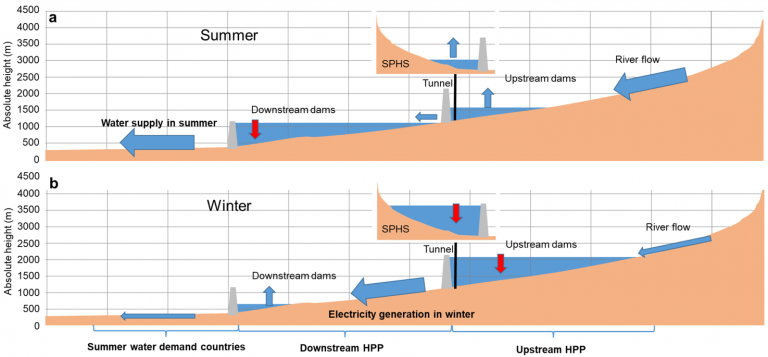Reviewed by Alex SmithMay 4 2022
Scientists from the IIASA Energy, Climate and Environment Program discovered that a “dual water and energy storage scheme,” which also lays the groundwork for high shares of renewable energy generation in the region, would dramatically increase agricultural efforts in downstream countries in Central Asia, which have conventionally been hindered by a lack of water for irrigation during the summer growing season.
 Schematic of the proposed “dual water and energy storage scheme” that can resolve the mismatch between water availability for electricity generation and irrigation. The size of the arrows indicates the amount of water flow in each season. Red arrows show the discharge of water from dams. HPP: hydropower plant; SPHS: seasonal pumped hydro storage. Image Credit: © Zakeri, B., et al., 2022.
Schematic of the proposed “dual water and energy storage scheme” that can resolve the mismatch between water availability for electricity generation and irrigation. The size of the arrows indicates the amount of water flow in each season. Red arrows show the discharge of water from dams. HPP: hydropower plant; SPHS: seasonal pumped hydro storage. Image Credit: © Zakeri, B., et al., 2022.
The study was published in the Journal of Energy Storage. Behnam Zakeri explains how the current situation differs from the past:
The five countries we looked at in Central Asia were once part of the Soviet Union. When their infrastructure was developed during this period, there was no consideration that they would one day be five separate and independent countries. The separation has led to a mismatch between their interests and their available resources.
Behnam Zakeri, Study Lead Author, International Institute for Applied Systems Analysis
Zakeri went on to explain that the upstream countries of Tajikistan and Kyrgyzstan regulate more than 80% of Central Asia’s freshwater resources. If they only used the water for their own needs, the water might primarily be used to generate electricity in hydropower dams during the winter, when the demand for electricity is highest.
This water will indeed flow down during the winter, when downstream countries do not really need as much water, but would dry up in the summer when their peak agricultural season necessitates irrigation.
The advancement of a so-called “Dual water-energy storage scheme,” according to Julian Hunt, a co-author of the study, is the key to the solution. Throughout the year, the suggested scheme establishes two distinct hydrological cycles in upstream and downstream areas, separating the seasonal demand for water for hydroelectricity and irrigation.
This can be achieved by building hydro reservoirs in upstream areas backed with seasonal pumped hydropower storage (SPHS) to store water for hydropower generation and meet energy needs in upstream countries in winter. When this water reaches lower elevations, existing reservoirs downstream can be employed to store water until summertime to serve water demand for irrigation in downstream countries.
Julian Hunt, Study Co-Author, International Institute for Applied Systems Analysis
Excess renewable energy produced in the lower reaches during the summer, when wind and solar resources are abundant and energy demand is low due to a mild climate, is used to pump the water from lower elevations back to the top for re-use at less abundant times of the year.
This type of prospective energy storage is a long-term solution that goes far beyond the capabilities of batteries. Using that plenteous clean energy would allow hydroelectricity to be saved for the winter when the solar generating potential is lower but electricity consumption, heating and lighting are higher.
In this paper, we propose integrated, cross-sectoral storage solutions that can resolve the temporal mismatch between the needs and availability of resources, which can potentially solve the transboundary water and energy conflicts in the region.
Behnam Zakeri, Study Lead Author, International Institute for Applied Systems Analysis
Zakeri adds, “Our proposal shows that, with political and economic cooperation, investments in infrastructure can be made in one or two countries upstream, while benefits flow throughout the entire region, including water and energy security as enablers of sustainable development.”
The investigators used MESSAGEix, an open-source systems optimization model developed by IIASA, to generate the most cost-effective scenario for reducing CO2 emissions from electricity generation while ensuring water supply.
Hunt was also the lead author of a Nature Communications study published in 2020 that included a complete map revealing a large number of locations that could benefit from similar seasonal pumped hydroelectric systems.
Journal Reference:
Zakeri, B., et al. (2022) Role of energy storage in energy and water security in Central Asia. Journal of Energy Storage. doi.org/10.1016/j.est.2022.104587.